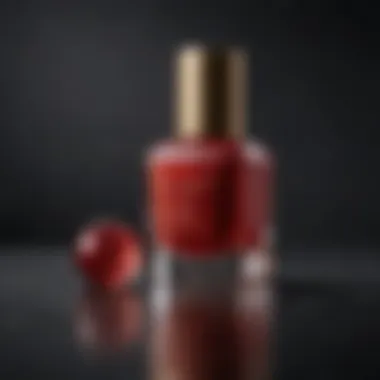A Comprehensive Guide to Removing Dip Nail Polish at Home


Intro
Removing dip nail polish at home can seem daunting, yet it is easier than it looks. For some women, maintaining elegant nails is essential for their sense of style and presentation. Dip powder nails provide a long-lasting and vibrant finish, making them a popular choice. However, when it comes time for removal, it is crucial to do so safely to avoid damaging the nail bed.
In this guide, we will break down the process of removing dip nail polish effectively. We will also discuss the necessary tools, various removal methods, and tips for taking care of your nails afterward. Understanding the science behind dip nails will also be key in knowing how to remove them properly. By the end of this guide, you will be empowered to maintain healthy nails while achieving a professional look from the comfort of your home.
Trend Report
Latest Beauty Trends
In recent times, nail aesthetics have become a significant trend within the beauty community. More women are opting for dip nail polish due to its durability and extensive range of colors. This technique reduces the risk of chipping and provides a glossy, salon-quality finish that lasts for weeks.
Seasonal Trends
Seasonally, dip nails have embraced various colors reflecting seasonal palettes. In spring, pastel shades dominate. For summer, vibrant colors take center stage. Fall tends to favor deeper tones, while winter showcases glitters and metallics. By choosing the right shades, you can keep your nail game on point all year round.
"Choosing the right color can greatly enhance your overall look, making nail care an important part of self-presentation."
Beauty Hacks
Along with trends, beauty hacks surrounding dip nails have emerged. Techniques such as layering glossy top coats or incorporating nail art designs offer a personalized touch. These hacks can be performed at home with minimal investment and equipment, making them accessible for everyone.
Tools and Materials
To successfully remove dip nails at home, you will need:
- Acetone
- Cotton balls or pads
- Aluminum foil
- A nail file
- Cuticle oil
These materials are essentials that facilitate the effective removal process without causing excessive damage to your nails. Each item works together to weaken the bond of the dip powder, allowing it to lift off gracefully.
Removal Methods
There are typically two methods for removing dip nail polish: the soak-off method and the filing method.
Soak-Off Method
- Begin by gently buffing the top layer of the dip powder using a nail file.
- Soak a cotton ball in acetone and place it on the nail.
- Wrap the fingertip with aluminum foil to keep the cotton in place.
- Wait for around 10 to 15 minutes.
- Remove the foil and cotton, then gently scrape off the softened dip.
Filing Method
- Using a nail file, carefully file away the top layer of the dip nail polish until you see the natural nail.
- Be cautious not to file too deeply, as this can damage your nails.
- Finish by smoothing any rough edges and applying cuticle oil.
Troubleshooting Common Issues
Sometimes, the dip polish may not fully come off. If this happens, consider extending the soaking time or ensuring the acetone is adequately saturating the cotton. In rare cases, if you notice excessive pain or irritation, it is wise to stop and seek professional help.
Aftercare Tips
After removing dip nails, aftercare is critical. To maintain nail health, apply a nourishing cuticle oil. Regularly moisturizing your nails and hands is essential too. This habit promotes recovery and reduces the risk of breakage in the future.
Understanding the complete process can transform nail maintenance into a simple and effective routine, ensuring that your nails are not just beautiful, but also healthy.


Understanding Dip Nail Polish
In recent years, dip nail polish has become a prominent choice for those seeking durable and fashionable nails. Understanding dip nail polish is crucial when discussing removal methods as it helps establish why the process may differ from traditional nail polish. Dip nail polish is a system that binds color powders with a bonding solution to create a long-lasting finish. This understanding informs the removal techniques explored in this guide.
What is Dip Nail Polish?
Dip nail polish is a specialized form of nail coating that is applied in layers. It involves the dipping of nails into color powders, which adhere to a base coat that contains a bonding agent. This layered process not only enhances the aesthetics but also contributes to its resiliency. The unique combination allows for a glossy and chip-resistant finish, which many find appealing. Unlike regular polish, dip nails typically last longer, often up to three weeks, making them a popular choice for individuals with busy lifestyles.
Benefits of Dip Nails
Dip nails offer several advantages over traditional nail polish. One significant benefit is the durability; they are significantly less prone to chipping. This longevity saves time and frequent reapplication, an important consideration for many users. Furthermore, the application process allows for intricate designs, as the powder is versatile enough to achieve various looks.
- Quick Application: Unlike gel nails, dip nails can be applied without a UV light, making the process faster.
- Variety of Colors: The market offers numerous shades, and the ability to mix colors expands creative possibilities.
- Strengthening: Many individuals find that dip nails provide additional strength to their natural nails during wear.
Potential Drawbacks
While dip nails have many benefits, users should also be aware of potential drawbacks. One of the most commonly cited issues is the removal process, which can be more involved than that of regular polish. Improper removal can lead to nail damage or weakening. Additionally, some bonding agents used in dip systems may cause allergic reactions or skin sensitivity for certain individuals.
- Nail Damage: If removed incorrectly, the natural nail may become thin or brittle.
- Chemical Exposure: Acetone and other removers can be harsh on skin and nails, leading to dryness or irritation.
- Cost Factors: Professional application and removal can be more expensive compared to traditional polish services.
Understanding both the advantages and challenges of dip nail polish sets the stage for effective removal strategies. By recognizing these factors, readers can make informed decisions on their nail care routine.
Preparation for Removal
Preparing for the removal of dip nail polish is a crucial step for ensuring a smooth and effective process. Without adequate preparation, the removal can lead to adverse effects on both the nails and the surrounding skin. The importance of proper preparation becomes even clearer when considering that dip nails are known for their strong adhesion. Assessing the tools, environment, and workspace before proceeding can drastically enhance the experience and final results during removal.
Gathering Necessary Tools
To remove dip nail polish effectively, one must first gather the appropriate tools. Having everything on hand not only saves time but also minimizes frustration while performing the procedure. Here are the essential tools required to get started:
- Acetone or Non-Acetone Remover: Acetone is highly effective for removing dip polish, while non-acetone options may be preferable for those with sensitive skin.
- Nail File: A coarse nail file helps in gently buffing the top layer of the dip polish, allowing for better penetration of the remover.
- Cotton Balls or Pads: These will be used to apply the remover to the nails.
- Aluminum Foil: This can be cut into strips to wrap around cotton balls, keeping them in place while the remover works.
- Cuticle Pusher: A cuticle pusher is useful for removing any remaining polish after soaking.
- Buffers and Nail Clippers: For post-removal care, these tools help maintain nail health.
Choosing the Right Environment
The choice of environment plays a significant role in the nail polish removal process. A well-lit and spacious area promotes a comfortable and effective removal. Consider the following factors when selecting your environment:
- Ventilation: It is essential to work in a well-ventilated space, especially when using acetone, as its fumes can be strong and irritating.
- Surface: Choose a flat, hard surface to do the procedure. A table or countertop is ideal as it provides stability while working.
- Distance from Children and Pets: As nail polish removers contain chemicals that can be harmful if ingested, it is wise to keep children and pets away during the process.
Protecting Your Workspace
Protecting your workspace is a practical consideration that can prevent damage and maintain cleanliness. Dip polish removers can be harsh on surfaces, so take these steps to safeguard your area:
- Use a Protective Cover: Consider using an old towel or a disposable plastic sheet on the surface where you plan to work. This helps absorb any spills and protects the underlying surface.
- Keep Necessary Items Nearby: Ensure that all tools and materials are organized and within reach to avoid unnecessary movement that can result in spills or mess.
- Have Cleaning Supplies Available: Accidental spills are possible, so keep paper towels or wipes ready for quick clean-up. This ensures that any shocking moments during the process do not lead to prolonged messes.
"Preparation is the key to a hassle-free removal experience. Proper planning can save time and reduce the risk of damage to your nails and workspace."
By taking the time to prepare for the dip nail polish removal, you set yourself up for success. The next steps will be smoother and more efficient, leading to safer outcomes and healthier nails.
Methods for Removing Dip Nail Polish
Understanding effective methods for removing dip nail polish is crucial for those who wish to maintain the health of their nails while achieving the desired aesthetic. Different methods offer unique benefits and considerations that impact the effectiveness of the removal process. From using acetone to alternative removers and various application techniques, knowing how to approach this task correctly can save time and minimize nail damage. This section will explore a variety of methods that are popular among users, highlighting their advantages and disadvantages.
Using Acetone


Effectiveness of Acetone
Acetone is a widely known solvent in the nail care industry. Its effectiveness lies in its strong ability to break down the polymers used in dip nail polish. This characteristic makes acetone a go-to choice for many when removing dip nails. It works swiftly, usually allowing for removal in a timely manner. However, it is essential to note that acetone can dry out the nails and surrounding skin, resulting in potential long-term damage if used excessively. Therefore, employing it judiciously is vital.
Application Techniques
Using the right application techniques can enhance acetone's effectiveness. One popular method is soaking cotton balls in acetone, placing them on the nails, and wrapping each fingertip in aluminum foil. This creates heat, which speeds up the removal process. Another method is to dip the entire nail into a bowl of acetone. While effective, this can be messy and require extra care. Overall, using acetone with these techniques ensures an efficient removal while minimizing time spent.
Non-Acetone Removers
Comparison of Effectiveness
Non-acetone removers are often marketed as a gentler alternative to acetone. While they are less effective in breaking down dip nails, they provide a solution for those concerned about nail health and skin irritation. The effectiveness varies among different brands but tends to take longer compared to acetone. A unique feature of these removers is that they often include moisturizing ingredients, which can help alleviate some of the harshness associated with nail polish removal.
Best Brands Available
There are several brands known for their non-acetone replacements. Some popular options include Zoya Remove Plus, OPI Expert Touch, and Orly Gel FX. Each brand has its own formulation, which often includes additional skin-friendly components. However, these non-acetone products may require multiple applications to achieve the same results as acetone, potentially making them less appealing for those seeking quick removal.
Wrap Method
Step-by-Step Process
The wrap method is a popular technique for removing dip polish that involves wrapping the nails in materials soaked with acetone or a non-acetone remover. The process begins by soaking a cotton ball or pad in the remover, placing it over the nail, and then wrapping the fingertip in foil or plastic wrap. This step creates an airtight seal, allowing the remover to break down the polish more effectively. Following this method can lead to easier and less abrasive removal.
Duration for Effective Removal
To achieve effective removal using the wrap method, a duration of about 10 to 15 minutes is typically advised. During this time, it is beneficial to monitor the progress. If the polish does not lift easily after this period, it may need more time. Adjusting the duration provides flexibility based on the specific polish used and personal preference.
Soaking Method
Preparation of Soak
The soaking method involves immersing the nails directly into a bowl of acetone or soaking solution. To prepare, fill a small bowl with the chosen remover, ensuring enough liquid to cover the nails completely. Some users may choose to add a few drops of essential oils for a more pleasant experience. This method is straightforward and often effective but requires caution to prevent skin contact with the solvent.
Expected Outcomes
When using the soaking method, the expected outcome is the complete lifting of the dip polish within about 15 to 20 minutes, depending on the specific product used. Patience is key, as achieving the desired result may take some time if the bond of the polish is particularly strong. After soaking, gently push off the remaining polish with a wooden stick rather than scraping, which can lead to nail damage.
It is essential to take special care of your nails and cuticles after removal to restore moisture and strength.
Troubleshooting Common Issues
Removing dip nail polish can lead to certain challenges. Understanding and addressing these challenges is crucial for achieving a smooth, damage-free experience. Common issues include nail damage, difficulties in removal, and skin irritation. By recognizing these problems, you can adopt preventive measures and find effective solutions.
Nail Damage Concerns
Nail damage is a prevalent worry among those who use dip nail polish. Continuous application and removal can weaken the natural nails. After removing dip polish, some individuals notice thinning, brittleness, or peeling of their nails. This concern is not unfounded. The chemicals in dip systems, especially when removal is done incorrectly, can compromise nail health.
To minimize potential damage, it is essential to allow sufficient time for your nails to recover between applications. Proper technique during removal plays an important role as well. Avoid scraping the dip nails harshly, and follow the recommended soaking methods. Additionally, consider applying a strengthening base coat before reapplying dip polish. This can foster a buffer against potential harm.
Difficulty in Removal
Many can find removing dip nail polish challenging. The adhesive nature of this polish means it may not lift away easily, leading to frustration. If you struggle with removal, you might be applying inadequate products or lacking the right techniques.


Using pure acetone is usually effective. However, the method you choose is just as vital. Ensure that you are following the correct procedure, such as wrapping or soaking, and giving it ample time to work.
If one method fails, switch to another. For instance, non-acetone removers might take longer, but they can be gentler on the nails and surrounding skin. Adjusting your approach based on your experience becomes necessary to find what works best for you.
Skin Irritation
Skin irritation is another common issue tied to the removal of dip nails. When acetone or other removal products come into contact with the skin, they may cause dryness, redness, or peeling.
To avoid this, consider applying a barrier, such as a thick moisturizer or vaseline, around the nail area before using acetone. This can protect your skin from harsh chemicals. After removal, always take care to moisturize the hands and cuticles. Products designed for nail care can promote recovery and reduce the risk of irritation.
"Proper aftercare reduces irritation and supports healthier nail regrowth."
Assessing skin reactions during the removal process becomes crucial. If irritation persists, take a break from dip applications until the skin heals completely. Your skin's comfort should be a priority in your nail care routine.
Post-Removal Care
Proper post-removal care is crucial after removing dip nail polish. This phase ensures that your nails regain their strength and health. Removing dip nails can sometimes lead to issues like dryness and brittleness. Therefore, focusing on post-removal practices can significantly improve the overall condition of your nails. This section discusses essential elements such as nail treatment options, cuticle moisturization, and nail strengthening strategies.
Nail Treatment Options
After you have removed the dip polish, consider treating your nails to restore their natural shine and health. A few effective treatments include:
- Nail Oils: These are designed to penetrate the nail and cuticle area, providing hydration and nourishment. Look for products with ingredients such as jojoba oil or vitamin E.
- Nail Strengtheners: These treatments contain proteins or polymers that bond to the nail, enhancing its strength temporarily.
- Hydrating Creams: A thick moisturizer can help to soothe both nail and cuticle, preventing further damage.
Remember to choose treatments that do not contain harsh chemicals. Natural options are often gentler and provide better long-term results.
Moisturizing the Cuticles
Cuticles play an important role in protecting your nails. They act as barriers against bacteria and fungal infections. After removing your dip nails, moisturizing the cuticles is essential. This practice restores moisture and prevents cracking and peeling.
To moisturize effectively:
- Apply cuticle oil or cream that suits your skin type. Look for products enriched with natural ingredients.
- Gently massage the oil or cream onto the cuticle area. This enhances circulation and promotes healthier nail growth.
- Repeat this process regularly, at least twice a week, for optimal hydration and care. This can significantly help in maintaining the integrity of both your cuticles and nails.
Strengthening Nails After Dip Polish
Following dip polish removal, your nails may feel weak or thin. It is important to implement a strengthening regimen to help them recover. Here are some strategies you can follow:
- Biotin Supplements: Taking biotin can enhance nail health over time. It is known to strengthen brittle nails.
- Avoid Water Soaking: Limit prolonged exposure to water which can weaken nails further. When washing hands or dishes, try using gloves for protection.
- Regular Trimming: Keeping nails trimmed can minimize the risk of splits and breaks. Opt for a nail file to shape them rather than clippers, which can cause further stress.
By paying attention to your nails and cuticles after removing dip nail polish, you ensure long-term health. Implementing these post-removal care practices can help achieve beautiful, healthy nails.
"Regular care not only enhances appearance but also contributes significantly to nail longevity."
Emphasis on post-removal care cannot be overstated. Following these guidelines will not only prepare your nails for the next application but can also maintain their durability and attractiveness.
Finale
Removing dip nail polish at home may seem challenging, yet it represents an important skill for those who value nail health and appearance. It allows individuals to maintain their nails in a cost-effective manner and to customize their nail care routine according to personal preferences. Understanding the removal processes discussed in this article, from the right preparation to post-removal care, equips readers with the knowledge necessary to handle their nail care more effectively.
Recap of Key Points
- Dip Nail Polish Overview: Dip nails are durable, offering extended wear, but can be challenging to remove without the right techniques.
- Preparation: Gathering the necessary tools ensures a smooth removal process. A clutter-free environment and protective measures can facilitate easier cleanup.
- Removal Methods: Different methods, whether acetone or non-acetone removers, present distinct effectiveness levels. Each removal technique has its advantages, and understanding them is crucial.
- Common Issues: Reading about troubleshooting can help in addressing nail damage or irritation effectively without compromising nail integrity.
- Aftercare: Proper nail treatment and moisturizing cuticles are essential in maintaining nail health post-removal.
Final Thoughts
By mastering the art of removing dip nail polish, individuals gain control over their nail care. It fosters a deeper understanding of one's nails, enabling better decisions in nail health and aesthetics. This guide emphasizes not just on removal techniques but also on the importance of care before, during, and after the process. For women of all ages, having this practical knowledge empowers them to maintain their desired nail look while ensuring longevity and health of their natural nails.
"Knowledge is power, especially when it comes to self-care."



